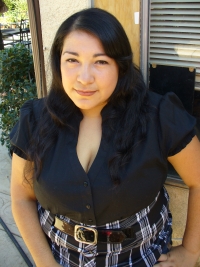 America X. Gonzalez is a Speech Language Pathologist Assistantat the Spectrum Center San Pablo, a private school for children with autism, Asperger Syndrome and severe emotional distress in California, USA.
America X. Gonzalez is a Speech Language Pathologist Assistantat the Spectrum Center San Pablo, a private school for children with autism, Asperger Syndrome and severe emotional distress in California, USA.
Here America answers some questions about her new book, Speech in Action: Interactive Activities Combining Speech Language Pathology and Adaptive Physical Education, co-authored with Lois Jean Brady and Jim Elliott.
What motivated you to become a speech and language pathologist assistant?
As a young child I found myself having trouble communicating because I was an immigrant from Mexico and only spoke Spanish. I was merely six years old when I came to this beautiful country and I had nothing more than a dress. I spoke very little English; enough to greet others and say ‘thank you’. My limited English caused me to become ashamed of speaking as many kids made fun of my accent when I tried to speak. The fact that my name was America didn’t help things either. The kids would say, “how come you don’t speak English if your name is America?” and then they would laugh. But within a year I learned a lot of English and felt more confident in my writing and reading abilities. Speaking, however, was still scary for me because I still had an accent that others would tease me for.
As time went by I had great teachers who encouraged me to speak and gave me more confidence. They nurtured me until I felt comfortable enough to speak in front of audiences and young leadership conferences. That is when I realized that I could help others find their voice. Maybe they didn’t have an accent problem. Perhaps they needed to articulate better or learn how to make their mouths make certain sounds. But in the end they all lead to the same place: a person who feels like they can’t communicate effectively. And I was determined to help so that they wouldn’t feel like I once had felt when I was ridiculed. I wanted to make a difference so I became a Speech Language Pathologist Assistant. My journey to getting a Master’s in Speech Pathology hasn’t been a straight line. Along the way I took some detours to get a degree in Early Childhood Education teaching, received a bachelor’s in Psychology and took courses in Applied Behavioral Analysis. I am currently going back to school to get my Master’s.
Tell us how this book came together – where did the many activities come from?
The idea of combining speech and physical education was inherently intertwined in our lesson plans before we even knew we were combinig them. Most of our lessons were already mixing these practices because we found that when we kept the lessons fun and active the students learned more due to a longer attention span. One day I was teaching a group of three students in a small therapy cubicle. The lesson that day was comparing and contrasting. So I prepared a CD with different genres of music that I would play for them. As they listened to the music we would all get up and dance around to the beat for a minute. Then as we caught our breaths we would sit down and compare the selection to the one we had just heard before that. The students loved comparing the music because I also included foreign music. As we were doing our goals one of the students got a little too excited and did the splits which made the other two kids jump backwards and push me into the wall where I bumped my elbow. As I was rubbing my elbow the adaptive physical education teacher, Jim (Elliott), came in and asked why I was playing such cool music. I told him about the lesson and the kids’ goals and he got excited. He invited me over to the Movement Room where he did therapy. That room was huge and we had enough room to do all the splits we wanted. We did that lesson and soon we started working on more lesson plans incorporating speech and movement. We kept a book with our lessons in it. Lois, the other author, was also working with Jim to get words out of her student. So that was the begining of Speech in Action.
How did the illustrator, Byron Roy James, become involved?
Lois had Byron as a client and she soon realized that he was very adept at drawing cityscapes and mechanical things. She challenged him to draw human figures and expand his repertoire. She also saw something in him that made her want to reach out and give him an opportunity. In our jobs we strive to help our students as much as we can. It felt natural to help one of our students feel proud of seeing their art in a book. We wanted him to see that he can do whatever he puts his mind to. I can only imagine the sheer joy he must have felt as he got his hands on the book and saw his name and his art inside the pages of Speech in Action. I wish I had been there to see that!
Why does the SLP/APE combo work particularly well for children on the autism spectrum?
Temple Grandin has said that as a child she learned from her tutors who always made sure to incorporate a real life example together with the abstract word she was learning. For instance, if they were trying to teach her the word “jump”, her tutors would show her the word “jump” but would then ask her to jump. Temple says that learning in this manner makes more sense due to the fact that children with autism need help understanding abstract concepts such as writing or symbols. Another reason why Speech in Action works well with children on the autism spectrum is because it is fun. Plain and simple, if the student is having fun and being active in his learning he will have your attention. In order for learning to take place the information has to reach the student. If the student is bored out of his or her mind they won’t pay enough attention to learn anything. On the other hand, if they are actively engaged in a lesson they will pay enough attention to allow the information to enter their brains. They might need some repetition to completely learn the concept but since the activities are fun the kids beg us to do them all the time. To keep the lessons fresh we can also take the lesson to a different locale. That is another great feature of Speech In Action. Portability allows us to take these lessons anywhere and the variations allow us to change them around as the student becomes more proficient in the goal being taught.
What are some easy ways that teachers can integrate these exercises into the school day?
 The easiest way for teachers to incorporate the lessons in the book is to just jump right in, pick an activity and follow the directions. The materials needed to do most of the activities in this book have been purposefully kept to a bare minimun, some having no materials needed at all, in order to make it easy for parents and teachers to do. We wanted to make it super simple, fun and effective. All of our lessons are goal oriented so teachers and parents can feel comfortable picking any activity and knowing that heir children will be learning something.
The easiest way for teachers to incorporate the lessons in the book is to just jump right in, pick an activity and follow the directions. The materials needed to do most of the activities in this book have been purposefully kept to a bare minimun, some having no materials needed at all, in order to make it easy for parents and teachers to do. We wanted to make it super simple, fun and effective. All of our lessons are goal oriented so teachers and parents can feel comfortable picking any activity and knowing that heir children will be learning something.
But best of all, the kids will be having so much fun that they will think they are just playing instead of working on their goals. I often get questions from new teachers who are not familiar with my way of teaching. They say, “I asked Athena what she did in speech class today and she said she just played. She says she never works and only plays fun games.” I always laugh at this and I love it when I have to explain that my lessons are meant to make the student feel as if they are only playing, but in actuality they are working on their individual educational goals. My motto is, if they’re not having fun they’re not learning.
The book also offers guidance on communicating praise to children in speech therapy. Why was it important to include this chapter?
The chapter on how to praise a child was a very important piece of the book because everything we teach should be done right. I am a firm believer in helping children to grow in a nurturing environment. One filled with praise, even if we fail. Afterall, we learn more from our mistakes than we do from our achievements. But praising can be tricky. If done incorrectly it is as if no praise was given at all. So we didn’t want people wasting their breath with praise that won’t have the desired effect, or worse, not even matter. An example of praise of that won’t make much difference would be to tell a child, “awesome”. The child might understand that you liked his work but won’t know WHY you liked his work. He won’t have the information needed to repeat this kind of work in the future. But if you say, “I liked how you wrote from the heart” then the student now has a praise that also carries vital information for repeted success in the future. He will write his future journal entries “from the heart” because that was a good thing to do. In the end, we want all children to thrive in a loving environment full of effective praises that will shape our beautiful young children’s brains into wonderfully bright minds.
Copyright © Jessica Kingsley Publishers 2011.